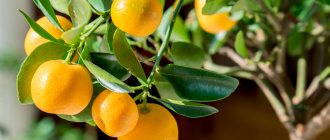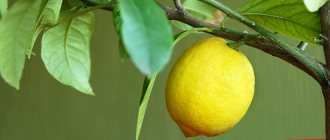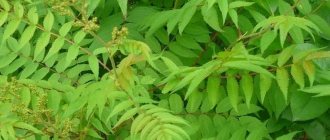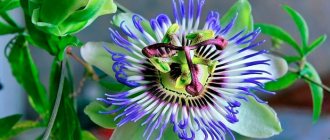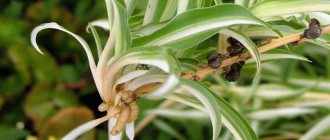Calamondin or citrofortunella is a hybrid bred indoor plant of the Rutaceae family, which also includes lemons, oranges, and tangerines. Obtained by crossing tangerine and kumquat. The scientific name is citrofortunella, the common name is house tangerine, golden orange.
Brought to the level of bonsai art for breeding copies of real trees in an apartment.
Description of calamondin
It has several names: citrofortunella microcarpa, golden orange, calamondin variegated, indoor mandarin. The most common name is citrofortunella. This hybrid is the result of breeders crossing a tangerine and a kumquat. Citrofortunella was brought to us from Southeast Asia.
Indoors, this tree grows up to 1 meter in height, although in natural conditions it can reach 5 meters. The crown is highly branched. The shoots are brown in color. The leaves are small in size. Flowers bloom in spring.
The fruits are small, only 15-20 grams. In appearance they are very similar to tangerines. It can be used instead of lemon, and the peel is also edible.
Botanical characteristics
Lemon Citrofortunella belongs to the rue family. The evergreen tree is the result of crossing a tangerine tree and a fortuneella (kumquat). A fast-growing, well-branching plant, it has compact dimensions, up to 1 m in height, small dark green foliage and a glossy surface with a pleasant citrus scent. The inflorescences are white and emit a characteristic aroma.
Citrofortunella has another name - calamondin.
The fruits are small in size, 3.0-4.0 cm in diameter, weighing about 15-25 g, similar in appearance to tangerines, and have a thin orange peel. The pulp of the fruit is too sour, with a bitter taste, and tastes like kinkan. There are a large number of seeds inside. Citrofortunella fruits have both pulp and peel that are edible.
This is a self-pollinating plant with a high percentage of fruit set. The possibility of flowering occurs in 2-3 years, in the summer season, the fruiting stage - in the middle of winter. Simultaneous flowering and fruiting often occur.
The lifespan of the plant is up to 5 years when grown at home and up to 20 years when grown in a natural environment.
Geography of growth
The wild homeland of lemon citrofortunella is the continental and island territories located between China, India and Australia, including the Indochinese Peninsula and the Malay Archipelago, as well as part of the Asia-Pacific region.
Recently, citrus has become widespread in home floriculture.
Creating conditions for growing calamondin
How to grow calamondin? Of course, it feels better in its natural environment, but it can also be grown at home.
- For citrofortunella, it is better to choose a spacious room so that nothing interferes with the growth of its branches.
- It is advisable that the room's windows face east in summer, and north in winter. You should not place a pot with this plant on the south side of the apartment. Very bright light negatively affects the fruiting of the tree. Sometimes leaves fall. If it is not possible to remove it from the sunny room, then you should install a barrier that provides diffused light, such as a dark curtain.
- In summer, it is recommended to take the tree out into the open air, but do not place it in direct sunlight.
- To ensure that the branches grow evenly, the tree is turned a few centimeters towards the sunlight every day.
- In addition, the tree must be protected from drafts.
- The optimal temperature that should be maintained in the summer during its cultivation is +25 degrees. In winter, it is reduced to +15 degrees.
- Caring for calamondin is not difficult, but an important factor for it is the watering regime. Golden orange is a fairly moisture-loving plant. The amount of water for irrigation is determined taking into account the temperature regime in which the tree is located. The main indicator that watering is required is the moment the soil dries out at a depth of 0.5 centimeters. The largest amount of water is applied in summer and spring, and by autumn watering is slightly reduced. Due to lack of moisture, the foliage turns yellow and then curls up. However, during flowering, calamondin is not watered so as not to harm fruit set.
- Golden orange is suitable for spraying with a spray bottle. The water should be settled and warm.
Note! A young plant needs more moisture than an adult citrofortunella requires.
Caring for Calamontodin after purchase
Most often, citrofortunella is purchased in a store, into which it ends up as a result of import from foreign countries. Therefore, a period of adaptation of calamondin to room conditions is required.
Often, after a purchase and a change in conditions, a flower becomes sick and its foliage actively falls off.
. A similar phenomenon is caused by stress suffered by calamondin. After all, his living conditions have repeatedly changed: the air temperature, its humidity, the degree of illumination of the room. The tree will need time and help from the owner to bounce back and adapt to the new apartment.
Advice!
If several leaves fall off the branches of a citrus hybrid within a day, you should put a plastic bag attached to the tree trunk on it as quickly as possible. Such actions will help to sharply increase the humidity level to 100%. At the same time, it is important not to forget to carry out the procedure of airing calamondin daily, for a short time, opening the package.
It is extremely important to provide the citrus plant with good lighting. If it is not enough, supplementary lighting with a special lamp is suitable.
Drafts in the room can negatively affect the development of citrofortunella.
What to do with a citrus plant after purchase - video
A plant grown abroad may contain special capsules with hormones in its root system. When leaves fly off a tree, it is necessary to extremely carefully and carefully check its root system and carefully transplant the citrofortunella into new soil and a new pot.
If roots are found that have succumbed to the process of decay, they must be cleaned immediately.
Even calamondin, which has lost absolutely all its foliage, has a chance of salvation. To resuscitate such a tree, you need to remove all existing fruits from it, which take all the strength from the plant, and cut off some branches. The cut areas must be processed using charcoal.
Photo of plant spraying
After these procedures, citrofortunella is sprayed with a special solution designed for the treatment of house plants and the prevention of diseases.
Spraying must be done once a day.
If the outcome is favorable, after half a month new young shoots will form on the trunk of the citrus hybrid.
Feeding Citrofortunella
Depleted soil during the growing season can be restored by applying fertilizers. Carry out root or foliar feeding of the tree.
- A fertilizer designed for citrus fruits will do. They are applied 3 times a month. In winter, it can be fed once every 30 days.
- Special fertilizer can be replaced with a mixture of ammonium nitrate and calcium chloride. The composition is prepared from 5 grams of saltpeter and 2 grams of calcium, which are dissolved in water. The application of such root fertilizer is carried out on the second day after watering in order to improve its absorption.
About the flowering of the tangerine tree
When the plant begins to bloom, you cannot move it from place to place so that the flowers do not fall off.
Also, during the period of active flowering, it is important to feed the tree with citrus fertilizer.
To see the fruits for which the tangerine tree is actually grown, you will have to work as a pollinator bee. We touch each white star with a brush and transfer the pollen to another flower. The fruits ripen for a long time, from 3 to 5 months, and grow very small, smaller than the tangerine we are familiar with.
Crown formation and pruning
One of the important factors for caring for calamondin is pruning. It is carried out for preventive purposes, as well as to create a beautiful decorative appearance of the tree. This procedure manages to form a crown and improve the health of the tree.
- Citrofortunella is pruned in late winter or early spring. They cut off shoots that spoil the decorative appearance, and also remove damaged shoots.
- The cut areas are treated with garden varnish.
- The formation of the crown of calamondin begins after the tree reaches 50 centimeters.
Calamondin: plant propagation at home
Plants from the Citrus genus have always attracted people with their beneficial fruits and decorative appearance. In addition, they were quite easy to grow by planting a seed from an eaten fruit in the ground. It is clear that under indoor conditions, fruits on such a seedling did not appear for decades.
However, over time, varieties and hybrids of citrus plants have been developed that bloom and bear fruit when grown in pots. Calamondin, the propagation of which is available to amateur gardeners, is one of the citrus crops that can be grown in pots to produce fruit.
What is calamondin and can it be propagated independently?
Calamondin is a representative of the Citrus genus of the Rutaceae family. The plant was obtained as a result of hybridization of mandarin with fortunella. In another way, its name sounds like it is composed of the names of plants of the parent forms - citrofortunella. From the genus Fortunella, the kumquat plant was involved in the production of the hybrid.
Citrofortunella, like kumquat, is most likely of Chinese origin. From where it came to other regions of Asia, Europe and the USA. The life form of calamondin is an evergreen low tree with good branching. In potted culture it can grow up to 2 meters in height, and in open ground - up to 5 m.
The leaves are medium-sized, smooth, dark green, shiny. They have a pleasant citrus aroma. The flowers are white and smell very good. The fruits are small, weighing 13-15 grams and up to 30 mm in diameter. They are more like miniature tangerines, as they have a slightly flattened shape and from 6 to 10 segments under a thin peel. The lobules themselves are separated by a thin transparent film.
The thickness of the peel is no more than 1.5 mm. Like the tangerine, the peel is easily removed from the pulp. The peel is edible, with a sweet taste. This plant is similar to a kumquat. Fresh fruits, like kumquat fruits, are eaten with the peel. The taste of the pulp is sour or strongly sour.
The plant is popular in indoor floriculture, as it looks simply gorgeous with orange fruits and white star flowers, which can be on the same plant at the same time. Calamondin is widely used for landscaping residential and office premises, for growing in winter gardens and greenhouses.
A large number of seeds can be found in the calamondin pulp. However, seed propagation of this crop is used extremely rarely.
After all, the plant is practically an intergeneric hybrid; grown from a seed, it may never bloom or bear fruit. At the very least, you need to wait a couple of five years for flowering.
In this case, the meaning of growing this citrus crop is lost. Therefore, the most acceptable methods of reproduction for this calamondin are:
Reproduction of calamondin by cuttings
The best time for propagation by cuttings in temperate climates is mid-summer. It is during this period that it is easiest to create the necessary temperature conditions for cuttings for rooting. It successfully takes place at + 25 + 26 degrees. For propagation, apical cuttings with three to four leaves are used.
Cut the cuttings with an oblique cut. The cut is dried in air for several hours. After this, it is treated with any growth stimulant. You can simply soak the cuttings in an epin solution for 10 hours. After this, the plant is planted in loose soil and covered with a jar.
This greenhouse is placed in good, but not direct sunlight.
It is important to ensure that the temperature does not fall below 25 degrees. Otherwise, the process of root formation will begin, and the cutting itself will simply die. During the day, the cuttings should be opened for ventilation for 30–40 minutes. When the soil dries out, watering is carried out, and phytohormones can also be used.
If all conditions are met, after three weeks the roots will begin to grow. Calamondin obtained from cuttings will begin to bloom and bear fruit in the third or fourth year. Given the low survival rate, several cuttings need to be rooted at once.
Reproduction by grafting
Propagation by grafting involves the participation of two plants. The first will act as a rootstock. For these purposes, it is convenient to use young orange seedlings. The grafting material – scion – will be harvested from the second plant. For this you need an adult calamondin. A small stalk is cut from it.
- calamondin review:
To carry out grafting, you can use the “bark” grafting technique. The best time for vaccination is spring - mid-summer. To do this, the rootstock is cut at a height of 10–15 cm.
Use a sharp knife to remove the bark from one side. The end of the cutting is cut so that an oblique cut 20–30 mm long is obtained.
With this side, the cutting is tucked behind the bark and secured with adhesive tape, wrapping it around the graft with the smooth, non-sticky side.
The grafted plant is covered with a bag or plastic bottle and placed in a warm place. After a month, the protective covering is removed, and after another 5-6 weeks, the adhesive tape can be removed. To do this, it is not necessary to unwind it. You can make a neat vertical cut along the entire length of the winding.
As it grows, the trunk will increase its diameter and get rid of the tape itself. In the future, caring for the plant consists of timely watering, fertilizing and replanting as it develops the pot. If everything was successful and calamondin began to bear fruit, its fruits are used:
- fresh
- for making sauces
- jams are made from them
- used for homemade candied fruits
Thus, citrofortunella or calamondin is not only a beautiful plant, but also useful.
Source: https://OgorodSadovod.com/entry/3260-kalamondin-razmnozhenie-rasteniya-v-domashnikh-usloviyakh
Rules for transplanting citrofortunella
Citrofortunella requires periodic replanting.
- After acquisition, citrofortunella are transplanted after 2-3 weeks. Then the tree is replanted every year, and the mature tree is replanted after 3 years.
- Transplant the plant into a larger pot, destroying the earthen ball. Drainage is poured onto the bottom of the replanted container, and on top of it is a mixture of turf soil, humus and sand.
- When replanting, make sure that the neck of the plant is above ground level.
- The transplanted tree is protected from drafts.
- The first application of fertilizer is carried out 1.5 months after this procedure.
How to propagate
Citrofortunella propagates by cuttings, seeds and grafting.
Cuttings are cut from the top of the crown on the eve of flowering. We try to trim so that there are 2-3 buds on a branch. We root in a solution that stimulates growth. This could be Kornevin or a heteroauxin solution. Leave it overnight, then plant it in a container with soil and cover it with a jar or bag.
We ventilate every day and monitor soil moisture. When the first leaves appear, we plant them in a permanent place. The plant begins to bear fruit in the second year of growth.
It is also easy to grow calamondin with seeds, but it should be noted that their germination rate is very low. Therefore, you will need to collect all the seeds of ripe fruits so that there is a greater chance of getting shoots.
We collect the seeds in the fall and leave them to dry well until spring. And in March, with the first days of spring, we immerse the seeds in a solution to stimulate growth for two days. Then we plant the seeds in a box with substrate to a depth of 2 centimeters. Cover the top with glass or film and leave it in the dark and warm. We ventilate twice a day.
When the first seedlings appear, we transfer them to a well-lit place and remove the cover. When the plants grow 3 or 4 leaves, we dive into individual containers.
I suggest watching a video about the propagation of citrofortunella from seeds.
Calamondin diseases
This indoor citrus tree can be affected by several types of diseases:
- sooty fungus;
- gommosis;
- anthracnose.
One of the main and first signs of the disease is blackening of the foliage.
- To prevent the spread of the disease to unaffected shoots, the plaque is cleaned off.
- If the manifestation of the disease is expressed in the form of slight yellowing of the foliage, then the plant is treated with a solution of copper sulfate.
- If the moment was missed and the leaves turned completely yellow, then in this case the plant is sprayed with fungicides.
If calamondin is not properly cared for, the plant may lose its leaves and the flowering period will not occur.
Diseases and pests of citrofortunella
Calamondin is often destroyed by diseases and pests. It is possible to revive a plant if the infection is detected in time and measures are taken to eliminate it.
Diseases
Most Citrofortunella diseases are caused by fungi. They reproduce well in high humidity. Some people like high temperatures, others prefer cold. The most common fungal diseases:
- Sooty fungus. Leaves, cuttings and shoots are covered with black dots. Flowering branches and fruits do not turn black.
- Anthracosis. With this fungal disease, small yellow-brown spots appear on the leaves, which gradually darken and merge. At the end, the calamondin sheds its leaves. The plant begins to hurt during the flowering period, before the ovary appears.
- Gommoz. The fungus begins to attack the tree from the roots. Then it spreads to the entire trunk, roughened areas, cracks, and gum stains appear on the bark. The leaves turn yellow and fall off, brown spots are visible on the fruits, and the tangerines also fall off.
To get rid of the fungus, the bush is treated with fungicides, copper sulfate, and Bordeaux mixture. When resuscitation is completed, watering is regulated and the room temperature is ensured. It is advisable to disinfect and ventilate the room well. It is recommended to tear off diseased parts of the plant and burn them.
Pests
Small bugs and worms often harm house plants, calamondin is no exception. Most often this type of citrus fruit is affected by:
- False shields. These are gray-brown insects 1.5-2.5 mm long; the larvae are covered on top with a kind of shield. They live on trunks and branches in colonies, are well camouflaged, damage the bark, which leads to a decrease in yield and death of the plant.
- Spider mite. Lives on the lower part of the leaf blade, covered with a thin web, sucks the juice from the plant. Small white dots are visible on the top of the leaf, and over time - brown dots. Eventually the leaves curl and fall off.
- Shield. The tiny insect parasitizes on the bark and is camouflaged with the help of a shield.
- Whitefly. A small winged insect, its larvae feed on plant sap. They leave sweet mucus on the leaves - a good substrate for mushrooms.
- Aphid. Large insects, up to 3 mm in length. They feed on the juice of leaves and stems and carry viral diseases.
It is recommended to combat pests in apartments using environmentally friendly methods. Insects that appear on the tree and the surface of the leaves are collected by hand, parts of the bush are washed with soap or alcohol solution, and sprayed with tobacco infusion. In extreme cases, insecticides are used. Pollination is carried out in a mask, then the room is well ventilated.
To purchase or plant citrofrtunella, you do not need experience or special knowledge. Before you bring this tropical plant into your home, you should carefully study the care rules, main diseases and pests of calamondin. Then the bush will grow healthy, please the eye and give a rich harvest.
Mistakes in growing citrofortunella
The main mistakes that inexperienced housewives make when growing calamondin:
- Insufficient amount of fertilizer applied or incorrectly selected composition.
- The presence of drafts in the room with the plant being grown.
- Frequent and sudden changes in air temperature in the room.
- Improperly organized irrigation regime.
But if care at home is carried out in accordance with the requirements, then a beautiful tree will grow that will bear quite edible fruits.
Varieties for home cultivation
A number of citrofortunella species are suitable for home floriculture:
- Peters are valued for their appearance. This is a highly decorative plant.
- Tiger is a small-fruited variety that is distinguished by foliage with a border or milky stripes.
- Shikinari is distinguished by its large fruit size and high taste.
- Variegatta is a variegated variety. Its fruits at the initial stage of development are colored with stripes, and by full technical ripening they acquire an even orange color.

